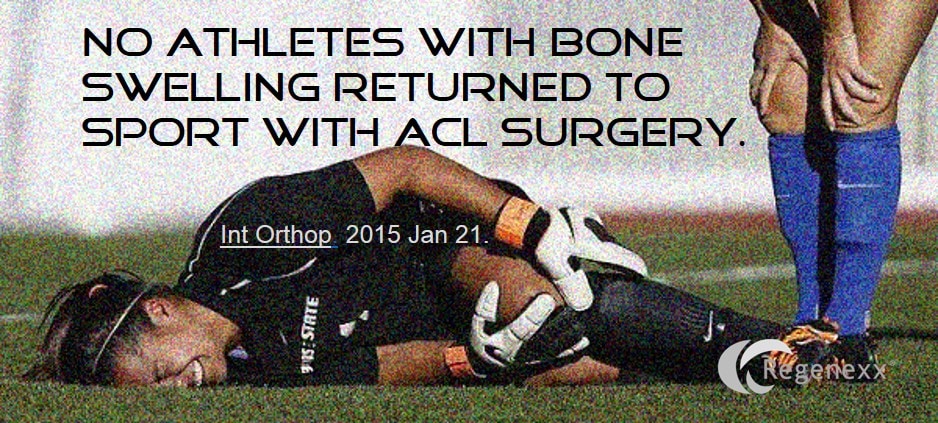ACL Surgery Results Impacted by Bone Bruising!
Most athletes believe that ACL surgery results are great, yet the research generally doesn’t support that view. However, is there a finding on the MRI of patients who injure their ACL that predicts who won’t be able to return to their sport even with surgery? If so, what are the implications for patients that have this finding?
When I tell young athletes that there is a 2/3rds chance that they will have arthritis by age 30 if they opt for ACL surgery, most are shocked. Most also don’t know that there’s a 29% chance that their brand new ACL graft will tear in the next 24 months or that the opposite knee is now much more likely to get an ACL tear. Few are also aware of research showing that return to sport may not be that different between ACL tear patients who opt for no surgery versus those opt for surgery.
With all of this bad news about surgical reconstruction of the ACL, is there a way we can predict who will have a hard time getting back to their sport even with surgery? A group in Italy just tried to answer that question by looking at the MRIs of 74 ACL injured knees and then observing who was able to return to sports after surgical reconstruction. Not too surprisingly, they found that patients with bone marrow swelling (what has been called a BML, but they termed a BME) did much more poorly in return to sports. How poorly? No patient that had this finding was able to get back to the field at full tilt. In addition, 54% of the patients had this bone swelling!
So what is a BML and why is it a big deal? BML stands for Bone Marrow Lesion and it means that there is an area of the bone that has been at least bruised, and likely has sustained micro-fractures. Recent research has shown that the cartilage above this area is under tremendous pressure to degenerate. So the 54% of patients in the study who had BMLs, also likely had a harbinger of bad cartilage to come, hence it’s not surprising that these patients never made it back to full activity sports.
The implications of this study (if these findings are replicated) are immense. It’s likely that half of all ACL tear patients aren’t benefiting from the surgery simply because their knee cartilage is at risk of future degeneration. What should be done for these patients? That’s one that will be hotly debated, but in our world, they should likely undergo a stem cell injection to treat the ACL and joint surfaces and if the BML persists, then we would likely use a precise injection to place stem cells into the BML (just as we have treated similar osteonecoris lesions for many years).
The upshot? This is a big study with big potential impacts in sports medicine. It may explain why ACL surgery results are so poor in many patients. In the meantime, it gives physicians practicing regenerative interventional orthopedics many ideas about how to help athletes return to their sport without surgery!

If you have questions or comments about this blog post, please email us at [email protected]
NOTE: This blog post provides general information to help the reader better understand regenerative medicine, musculoskeletal health, and related subjects. All content provided in this blog, website, or any linked materials, including text, graphics, images, patient profiles, outcomes, and information, are not intended and should not be considered or used as a substitute for medical advice, diagnosis, or treatment. Please always consult with a professional and certified healthcare provider to discuss if a treatment is right for you.

